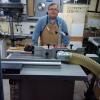Brent,
I'm reading your post with great curiosity; since you offered, I do have a few questions to ask
I'm noticing that some of the rebate heads have 4 cutters to the combi head's 2. Wouldn't that result in a difference in cut quality and cutter life? Such as:
https://www.whitehill-tools.com/cutt...eads/CBS004V3/
vs
https://www.whitehill-tools.com/cutt...eads/CBS002V3/
I look forward to learning more of the capabilities and how to integrate the machine into projects, your comments are really interesting to hear. Could you elaborate on how and what the use of a 'back fence' entails?
This is a rebate block in conjunction with groovers, or two groovers set on the spindle at once?
Could you explain what corrugated and serrated blocks are and their significance? What about when people say 'Euro block' is that another term for insert cutterhead?
Will probably take you up on that when I'm ready to order specific cutterheads and profiles. Thanks!





 Reply With Quote
Reply With Quote



